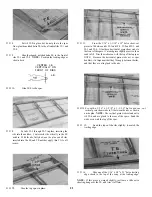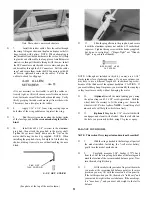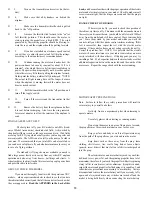
If you blow a fuse, or trip the overload protector, imme-
diately pull back the throttle stick and turn off any switches,
disconnect the battery, check the condition of the wire, switches and
other components, and replace if any are damaged Then replace the
fuse and check the operation of the system
WARNINGS: Do not use a fuse rated higher than 25
amps, and never operate the system without a safety fuse or
other type of overload protection, because doing so could easily
result in a fire, causing property damage and personal injury!
HOW TO ACHIEVE THE BEST PERFORMANCE
FROM YOUR ELECTRIC-POWERED MODEL
Whether you are Just starting to build your electnc-
powered airplane, or have already completed it, you will benefit
from the information that follows.
Your objective should be to build your airplane in such a
way that it will fly as it was designed GREAT! To insure that
it does, please read the following comments and suggestions very
carefully, and follow as many of them as you can
WEIGHT:
NOTE- In order to get a handle on this subject of weight,
you'll have to be able to accurately weigh your airplane at various
stages of construction A bathroom scale is definitely not suitable
for this. If you do not have access to a suitable scale, we suggest that
you take the airplane to your local post office and ask them to weigh
it for you.
We know from experience that this airplane, equipped
with a stock Goldfire motor, will R 0 G (takeoff from a hard-
surfaced runway) and fly satisfactonly with a fully charged 7 cell
battery pack IF the total weight is under 43 ounces Heavier
airplanes do not fly as well At 45 ounces it may not R 0 G , and
the climb rate will be disappointing An ElectroStreak that weighs
42 ounces or less will probably fly very well unless other factors are
introduced that reduce performance (see "Motor Performance" and
"Other Factors")
Keep the airplane as light as possible for best perform-
ance!
If you really got carried away with the glue bottle and your
airplane is "hopelessly overweight", consider using an 800 mAh
motor battery, rather than a 1200 mAh pack Although the flight
time will be reduced by a couple of minutes, the weight savings will
result in better performance
THRUST:
There are several factors that contribute to the way an airplane
flies, but the most important things you have control of are
WEIGHT and THRUST. Here are some ways you can insure
maximum thrust
Battery: In order to give the ElectroStreak sufficient power to
perform large acrobatic maneuvers, we strongly recommend that
you use a good quality 7-cell nicad battery pack for motor power.
The individual cells in the battery pack should be "low impedance",
which means that they are capable of delivering high current to the
motor (Sanyo SCR cells, for example)
Propellers: The Goldfire electric motor was designed especially
for powering airplanes by direct-drive It is well suited for this
application because it turns a relatively large (7x6 or 8x4) propeller
at an RPM that provides sufficient thrust for this airplane Because
it has a relatively low no load RPM (compared with some car
motors), you will not benefit by using a smaller diameter prop We
have tested many props and have found the Gnsh Tornado 7x6
(nylon) to be about the best for this airplane. You may want to
experiment with other props
Motor Break-in: Be sure to run your motor with no load (prop
removed) for at least 1/2 hour before using it in your airplane.
Because of the special design of the brushes, your Goldfire's
performance will continue to improve during the first several hours
of operation.
Peak Battery Charging: A fully charged battery pack will provide
an initial "surge" of power during the first 15 to 30 seconds of the
motor run, then the power curve stays fairly level for the next several
minutes If you do not charge your battery fully it will not deliver
that surge necessary for a good takeoff and climb out There are
three easy ways to "peak charge" your battery pack
1. Use a "peak-detecting" battery charger This type
charger will automatically charge your battery until it is fully
charged Unfortunately, this type charger is not yet available for use
with AC current, but it works very well when connected to a 12 volt
car battery.
2. You can monitor the voltage of your charging battery with
a voltmeter Your charger may have sockets into which you may
plug a voltmeter If not, you may insert the probes from the
voltmeter into the rear of the battery plug, making contact with the
metal portions As your battery charges, the voltage will gradually
increase When the battery is fully charged, the voltmeter will level
off or show a slight drop in the battery voltage At this point your
battery is fully charged NOTE: If, during the charging process,
your battery starts to get noticeably warm, disconnect the charger
immediately, as this means the pack is fully charged.
3. The third method of "peaking" your battery is by checking
its temperature As the battery charges it will remain cool until it
is almost fully charged When it reaches the fully charged state it
will rapidly build up heat You can feel this heat with your hand As
soon as the pack starts to noticeably warm up, disconnect it from the
charger Do not continue charging until the pack is hot! Over-
charging will damage your battery pack and can result in an
explosion.
Exercise Your Batteries: A new battery pack should be "cycled"
for best results You should peak charge the battery, then discharge
it almost completely by actually running your motor with the
propeller attached Do this 2 or 3 times on the ground before using
the new battery for flying Be sure you remove the battery from the
airplane between each cycle and allow it to cool before recharging
Wiring Harness: Standard "Kyosho" or "Tamiya"-type battery
connectors supplied with most batteries are normally adequate for
most installations However, if you are looking for maximum
performance, you may want to consider installing high-perform-
35






































